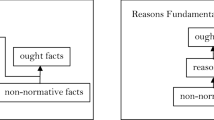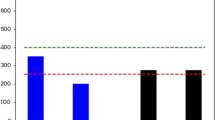Abstract
Arrow’s impossibility theorem states that if an aggregation rule satisfies unrestricted domain, weak Pareto, independence of irrelevant alternatives, and collective rationality, then there exists a dictator. Among others, Arrow’s postulate of collective rationality is controversial. We propose a new axiom for an aggregation rule, decisiveness coherence, which is weaker than collective rationality. It is shown that given the Arrovian axioms other than collective rationality, a dictatorship arises if and only if decisiveness coherence is satisfied. Moreover, we introduce weak versions of decisive coherence and examine these implications.
Similar content being viewed by others
Notes
Sen (1995) examines the notion of rationality in social choice through Buchanan’s criticism.
Cato (2016b) provides a comprehensive argument on fundamental properties of binary relations.
See Cato (2016b) for more detail on the operational expressions of the rationality properties.
Blair et al. (1976) provide a comprehensive analysis for path-independent social choice functions.
Suppose that f satisfies decisive congruence. By way of contradiction, assume that \(x \notin C_{R^*}(S \cup T)\) but \(x \in C_R(C_R(S) \cup C_R(T))\) for some \(x \in X\). Then, there exists \(y \in S \cup T\) such that \((y,x) \in \bigcap _{i \in M}P(R_i)\) for some \(M \in {\mathcal {D}}_f\). By definition, \((y,x) \in P(f(\mathbf {R}))\). Without loss of generality, we can assume that \(y \in S\). Since \((y,x) \in P(f(\mathbf {R}))\), it follows that \(x \in C_R(T)\) and \(y \notin C_R(S)\). Since \(y \notin C_R(S)\), finiteness implies that \((z,y) \in tc(P(f(\mathbf {R})))\) for some \(z \in C_R(S)\). Since \(tc(P(f(\mathbf {R}))) \subseteq tc(f(\mathbf {R}))\), \((z,y) \in tc(f(\mathbf {R}))\). If \((x,z) \in f(\mathbf {R})\), then \((x,y) \in tc(f(\mathbf {R}))\) and \((y,x) \in \bigcap _{i \in M}P(R_i)\). This contradicts (3). Thus, \((z,x) \in P(f(\mathbf {R}))\), by completeness. Therefore, we have \(x \notin C_R(C_R(S) \cup C_R(T))\), which is a contradiction. Thus, quasi path independence is satisfied.
For example, the following rule is not serially dictatorial, but satisfies all axioms: \(f(\mathbf{R})=R_1\) for all profiles.
Takayama and Yokotani (2017) carefully examine the structure of the set of conditionally decisive coalitions.
Consider the following axiom, which is an extension of decisive coherence:
Conditional decisiveness coherence: For all \(\mathbf {R} \in \mathcal {A}\), all \(M \subseteq N\), and all \(M' \in {\mathcal {D}}_f(M)\),
$$\begin{aligned} \left( f(\mathbf {R})\circ \left( \left( \bigcap _{i \in M} I(R_i) \right) \cap \left( \bigcap _{i \in M'} P(R_i) \right) \right) \right) \cup \left( \left( \left( \bigcap _{i \in M} I(R_i) \!\right) \cap \left( \bigcap _{i \in M'} P(R_i) \right) \right) \circ f(\mathbf {R}) \right) \subseteq P(f(\mathbf {R})). \end{aligned}$$Weak decisiveness coherence\(^{\star }\) is not necessary for (5).
References
Arrow KJ (1950) A difficulty in the concept of social welfare. J Polit Econ 58:328–346
Arrow KJ (1951) Social choice and individual values. Wiley, New York
Arrow KJ (1963) Social choice and individual values, 2nd edn. Wiley, New York
Bandyopadhyay T (1988) Revealed preference theory, ordering and the axiom of sequential path independence. Rev Econ Stud 55:343–351
Bandyopadhyay T (1990) Sequential path independence and social choice. Soc Choice Welf 7:209–220
Banks JS (1995) Acyclic social choice from finite sets. Soc Choice Welf 12:293–310
Blair DH, Bordes G, Kelly JS, Suzumura K (1976) Impossibility theorems without collective rationality. J Econ Theory 13:361–379
Blair DH, Pollak RA (1979) Collective rationality and dictatorship: the scope of the arrow theorem. J Econ Theory 21:86–194
Blau JH (1979) Semiorders and collective choice. J Econ Theory 21:195–206
Baigent N (1987) Twitching weak dictators. J Econ 47(407–41):1
Border KC (1983) Social welfare functions for economic environments with and without the Pareto principle. J Econ Theory 29:205–216
Brown DJ (1975) Aggregation of preferences. Q J Econ 89:456–469
Buchanan JM (1954) Social choice, democracy, and free markets. J Polit Econ 62:114–123
Buchanan JM (1975) A contractarian paradigm for applying economic theory. Am Econ Rev Pap Proc 65:225–230
Cato S (2010) Brief proofs of Arrovian impossibility theorems. Soc Choice Welf 35:267–284
Cato S (2012) Social choice without the Pareto principle: a comprehensive analysis. Soc Choice Welf 39(4):869–889
Cato S (2013a) Social choice, the strong Pareto principle, and conditional decisiveness. Theory Decis 75(4):563–579
Cato S (2013b) Quasi-decisiveness, quasi-ultrafilter, and social quasi-orderings. Soc Choice Welf 41(1):169–202
Cato S (2014) Independence of irrelevant alternatives revisited. Theory Decis 76(4):511–527
Cato S (2016a) Weak independence and the Pareto principle. Soc Choice Welf 47(2):295–314
Cato S (2016) Rationality and operators: the formal structure of preferences. Springer, Singapore
Campbell DE (1976) Democratic preference functions. J Econ Theory 12:259–272
Campbell DE, Kelly JS (2002) Impossibility theorems in the Arrovian framework. In: Arrow KJ, Sen AK, Suzumura K (eds) Handbook of social choice and welfare, vol 1. North-Holland, Amsterdam, pp 35–94
Denicolò V (1998) Independent decisiveness and the Arrow theorem. Soc Choice Welf 15:563–566
Ferejohn JA, Grether DM (1977) Weak path independence. J Econ Theory 14:19–31
Fishburn PC (1970) Arrow’s impossibility theorem: concise proof and infinite voters. J Econ Theory 2(1):103–106
Fishburn PC (1975) Axioms for lexicographic preferences. Rev Econ Stud 42:415–419
Fleurbaey M, Suzumura K, Tadenuma K (2005) Arrovian aggregation in economic environments: how much should we know about indifference surfaces? J Econ Theory 124:22–44
Gevers L (1979) On interpersonal comparability and social welfare orderings. Econometrica 47:75–89
Gibbard AF (2014) Social choice and the Arrow conditions. Econ Philos 30(3):269–284
Grether DM, Plott CR (1982) Nonbinary social choice: an impossibility theorem. Rev Econ Stud 49:143–149
Guha A (1972) Neutrality, monotonicity, and the right of veto. Econometrica 40:821–826
Hansson B (1976) The existence of group preference functions. Public Choice 28:89–98
Houthakker HS (1950) Revealed preference and the utility function. Economica 17:159–174
Kalai E, Muller E, Satterthwaite MA (1979) Social welfare functions when preferences are convex, strictly monotonic, and continuous. Public Choice 34(1):87–97
Kirman AP, Sondermann D (1972) Arrow’s theorem, many agents, and invisible dictators. J Econ Theory 5(2):267–277
Le Breton M, Weymark JA (2011) Arrovian social choice theory on economic domains. In: Arrow KJ, Sen AK, Suzumura K (eds) Handbook of social choice and welfare, vol 2. North Holland, Amsterdam, pp 191–299
Man PT, Takayama S (2013) A unifying impossibility theorem. Econ Theory 54(249–27):1
Mas-Colell A, Sonnenschein H (1972) General possibility theorems for group decisions. Rev Econ Stud 39:185–92
Matsumoto Y (1985) Non-binary social choice: revealed preferential interpretation. Economica 52:185–194
Ozdemir U, Sanver MR (2007) Dictatorial domains in preference aggregation. Soc Choice Welf 28:61–76
Parks RP (1976) Further results on path independence, quasitransitivity, and social choice. Public Choice 26:75–87
Plott CR (1973) Path independence, rationality, and social choice. Econometrica 41(6):1075–1091
Quesada A (2002) Preference profiles sustaining Arrow’s theorem. Econ Theory 20:623–627
Richelson J (1977) Conditions on social choice functions. Public Choice 31:79–110
Richelson J (1978) Some further results on consistency, rationality and collective choice. Rev Econ Stud 45:343–346
Samuelson PA (1938) A note on the pure theory of consumer’s behaviour. Economica 5(17):61–71
Schwartz T (1970) On the possibility of rational policy evaluation. Theory Decis 1:89–106
Sen AK (1969) Quasi-transitivity, rational choice and collective decisions. Rev Econ Stud 36:381–393
Sen AK (1970) Collective choice and social welfare. Holden-Day, San Francisco
Sen AK (1977) Social choice theory: a re-examination. Econometrica 45(53–8):9
Sen AK (1979) Personal utilities and public judgements: or what’s wrong with welfare economics? Econ J 89:537–558
Sen AK (1993) Internal consistency of choice. Econometrica 61(495–49):5
Sen AK (1995) Rationality and social choice. Am Econ Rev 85:1–24
Suzumura K (1976) Remarks on the theory of collective choice. Economica 43:381–390
Suzumura K (1983) Rational choice, collective decisions, and social welfare. Cambridge University Press, Cambridge
Tadenuma K (2005) Egalitarian-equivalence and the Pareto principle for social preferences. Soc Choice Welf 24(3):455–473
Takayama S, Yokotani A (2017) Social choice correspondences with infinitely many agents: serial dictatorship. Soc Choice Welf 48(3):573–598
Wilson R (1972) Social choice theory without the Pareto principle. J Econ Theory 5:478–486
Acknowledgements
I thank Maggie Penn, a managing editor of this journal, and three anonymous referees for their helpful comments. I thank Marc Fleurbaey, Kohei Kamaga, Koichi Tadenuma, Maurice Salles, Yohei Sekiguchi, and Kotaro Suzumura for discussions and comments. This work was supported by JSPS KAKENHI Grant number 26870477 and Postdoctoral Fellowship for Research Abroad of JSPS. I also thank the hospitality of Princeton University.
Author information
Authors and Affiliations
Corresponding author
Rights and permissions
About this article
Cite this article
Cato, S. Collective rationality and decisiveness coherence. Soc Choice Welf 50, 305–328 (2018). https://doi.org/10.1007/s00355-017-1085-1
Received:
Accepted:
Published:
Issue Date:
DOI: https://doi.org/10.1007/s00355-017-1085-1




